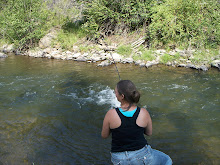Traveling Caravan Entry #4
Wednesday, June 26, 2013
Topic: Colonial
Dictionary of Clothing
This
lesson is coming from the book The Writers Guide to Everyday Life in the
1800’s by Marc McCutcheon. The
students are always amazed at how things have changed, especially fashion. In this unit we will study what was
popular for the Nineteenth Century versus the Twenty-First Century. Students will create a colonial vs.
Now-A-Days Clothing Dictionary, which will define the different clothing men
and women wore. (Content) (DOK1)
Pictures will also be shown of the
different parts of clothing from the nineteenth century and how it was
worn. Each student will be given a
picture of the clothing to paste in his or her dictionary. The students must write in the
definition I will shorten them. My
examples are from the Massachusetts Memorial Hall website because I forgot the
book that is sighted above at home.
Here are some examples of what I would include:
Womens Apparel:
Stockings vs Pantyhose
Everyone wore stockings. They were
worn over the knee and were held up by a little ribbon or belt known as a
garter. Stockings were knitted of cotton, silk or wool.
Drawers vs. Underwear
Drawers were like underpants.
Women's drawers weren't supposed to show but drawers on young girls and boys
did peek out from under their gowns. Men didn't wear drawers. Some drawers were
split, such as the ones shown here, to make the trip to the outhouse easier and
quicker
Corset vs. Shapers
Girls and women wore corsets to
make their figures look nice, but also to give support to their bodies when
they carried around heavy things such as milk buckets, firewood, or small
children. Many corsets were lined with stiffeners such as whalebone or metal.
This corset has a pocket in front which contains a "busk". The busk
helped make a woman's posture perfect. This corset laces up the back.
Gown vs Dress
This gown is typical of the new
style with its high waist, narrower skirt, and simpler lines. It has hooks up
the back. A gown might be decorated at the waist with a belt or ribbon. Young
girls often wore the same style of gowns as their mothers.
Men’s Apparel: http://www.history.org/history/clothing/men/mglossary.cfm
Banyan vs Robe
A gentleman's banyan was a loose, informal robe to be worn
instead of a coat. Influenced by Oriental fashion, these popular robes were
also called Indian gowns, nightgowns, or wrappers. Cut either in a loose
T-shape or as a long simplified coat, they were acceptable wear for home or
informal business. Made most often of patterned materials, these useful
garments could vary from light and cool to quilted and warm. (See also Negligé Cap)
Breeches vs pants
From the late 16th century until the early 19th century,
most men wore breeches as their lower body garment. Through the centuries
breeches were seen in many forms and lengths. In the early 18th century
breeches were barely seen beneath long waistcoats and coats. By the mid-18th
century they were more noticeable beneath shorter waistcoats and open coats,
and so the cut of breeches became tighter and revealed the shape of the leg.
Worn by all levels of society, breeches were made in a great variety of silks,
cottons, linens, wools, knits, and leathers. (See also Trousers)
Stockings or Hose vs Socks
Stockings of the 18th century were
worn by men and women, and were most often knit.
(Creative Activity) (DOK 2 & 3)
When
the Colonial Clothing dictionary is complete the students will draw their own
colonial outfit and label the parts. (DOK 4)
Standards:
3.1.1.A5, A9; 3.1.1.B6; 3.2.1.A1, A3, A6
8.3.1.A, c; 8.1.1.A, C

I have a whole list of clothing books on my blog for paper dolls and patriots lesson. They have some fine illustrations that might be helpful.
ReplyDeleteIllustrations would definitely be helpful. I am also looking for some good clothing book recourses. Thank you!
ReplyDeleteI like the idea of creating a dictionary. Did you get the booklet about clothing at Ephrata in your hands-on box last year? I've lost track of which years I gave that out.
ReplyDeleteI'd also suggest (as always) that you be specific about when. The 19th century isn't the colonial period (18th century), plus fashion changed a lot between 1800 and 1900, along with the usual caveat of where and who you were.
This looks like a fun project. Be careful not to confuse Depths of Knowledge questions with Bloom's taxonomy. Bloom's tax. would call creating a book higher level but Depth of knowledge would involve reasoning and conceptual understanding such as when, why, and what class of people would wear certain articles of clothing.
ReplyDelete